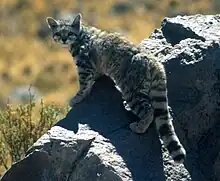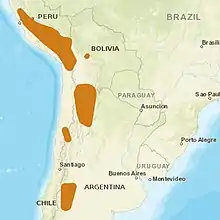Andean mountain cat
The Andean mountain cat (Leopardus jacobita) is a small wild cat native to the high Andes that has been listed as Endangered on the IUCN Red List because fewer than 1,500 individuals are thought to exist in the wild.[1] It is traditionally considered a sacred animal by indigenous Aymara and Quechua people.[3]
| Andean mountain cat | |
|---|---|
 | |
| Scientific classification | |
| Domain: | Eukaryota |
| Kingdom: | Animalia |
| Phylum: | Chordata |
| Class: | Mammalia |
| Order: | Carnivora |
| Suborder: | Feliformia |
| Family: | Felidae |
| Subfamily: | Felinae |
| Genus: | Leopardus |
| Species: | L. jacobita[2] |
| Binomial name | |
| Leopardus jacobita[2] (Cornalia, 1865) | |
 | |
| Distribution of the Andean cat, 2016[1] | |
| Synonyms | |
|
Oreailurus jacobita | |
The Andean mountain cat was first described by Emilio Cornalia who named it in honor of Jacobita Mantegazza. It is a monotypic species.[4]
Characteristics
The Andean mountain cat has ashy-gray fur, a grey head, face and rounded ears. The nose and lips are black with the areas around them being white; two dark brown lines run from the corners of the eyes across the cheeks. There are some black spots on the forelegs, yellowish-brown blotches on the flanks, and up to two narrow, dark rings on the hind limbs. The long bushy tail has six to nine rings, which are dark brown to black. The markings of juveniles are darker and smaller than those of adults. The skulls of adult specimens range in length from 100.4 to 114.8 mm (3.95 to 4.52 in) and are larger than those of the pampas cat and domestic cat.[5]
On the back and on the tail, the hair is 40–45 mm (1.6–1.8 in) long. Its rounded footprints are 4 cm (1.6 in) long and 3.5 cm (1.4 in) wide. Its pads are covered with hair. Adult individuals range from 57.7 to 85 cm (22.7 to 33.5 in) in head-to-body length with a 41.3 to 48.5 cm (16.3 to 19.1 in) long tail, a shoulder height of about 36 cm (14 in) and a body weight of up to 5.5 kg (12 lb).[4][5]
The Andean mountain cat and pampas cat look similar. This makes it difficult to identify which cat is observed and makes correct estimations of populations problematic. This can be especially difficult when attempting to gain correct information from the observations of individuals that have seen one of these cats but are not aware to look for specific features to distinguish between the two.[6]
| Andean cat | Trait | Pampas Cat |
|---|---|---|
| 2⁄3 of the total body length. Thick and blunt with six to nine wide rings. | Tail | 1⁄2 of the total body length. Thin and tapered with nine thin rings. |
| Maximum width of rings: 60 mm (2.4 in). | Tail rings | Maximum width of rings: 20 mm (0.79 in). |
| Distinctive lines on sides of eyes. Rounded tips of ears. | Facial features | If lines are present, they are brown and less dramatic. Triangular-tipped ears are present for most of this species. |
| Very dark or black. | Nose | Light colored, generally pink. |
| Yellow and rust-colored or gray and black. | Overall color | Cream, red, rust, and black in color. |
| One consistent coat pattern. | Coat pattern | Three different coat patterns with different variations. |
| Uniform coloration of the base color. | Ear color | Patterned colored ears. |
| Rings are not complete; stripes are spot-like in appearance. | Front paws | Two or more well-defined, complete, black rings. |
Distribution and habitat

The Andean mountain cat lives only at high elevations in the Andes.[7] Records in Argentina indicate that it lives at elevations from 1,800 m (5,900 ft) in the southern Andes to over 4,000 m (13,000 ft) in Chile, Bolivia and central Peru.[8][9][10][11] This terrain is arid, sparsely vegetated, rocky and steep showing that the Andean Mountain Cat prefers a temperate and terrestrial habitat. The population in the Salar de Surire Natural Monument was estimated at five individuals in an area of 250 km2 (97 sq mi).[9] Results of a survey in the Jujuy Province of northwestern Argentina indicates a density of seven to twelve individuals per 100 km2 (39 sq mi) at an elevation of about 4,200 m (13,800 ft).[12]
Its habitat in the Andes is fragmented by deep valleys, and its preferred prey, mountain viscachas (Lagidium) occur in patchy colonies. Across this range, the level of genetic diversity is very low.[11]
Behavior and ecology
The Andean cat is sympatric with the pampas cat and the cougar. The viscacha makes up 93.9% of the biomass consumed in the Andean cat's diet while the pampas cat depends on it for 74.8% of its biomass consumption.[9] Both cats depend on a specific prey to make up a large portion of their dietary needs. In some areas, the mountain viscacha makes up 53% of the Andean cat's prey items despite making up the vast majority of the biomass that it consumes. This is because the mountain viscacha is significantly larger in biomass than the other prey animals that the Andean cat hunts.[13] Other prey and food groups include small reptiles, birds, and other small mammals such as tuco-tuco. They also hunt frequently during the same periods. During one study, both the Andean cat and the pampas cat were seen most frequently during moonless nights; the second most sightings of these cats were during full moons.[14]
Based on residents' observations of Andean cats in coupled pairs with their litters, it is thought that the mating season is in the months of July and August. Due to kittens also being seen in the months of April and October, the mating season could also extend into November or December, although not much information is known about their breeding habits. A litter usually consists of one or two offspring born in the spring and summer months. This is also common in other species that have their young when food resources are increasing, which can influence the survival rate of the young.[15]
Threats
The Andean cat is threatened by such factors as habitat loss and degradation, hunting, and disease.[16]
Conservation
The Andean Cat is also listed on the IUCN Red List, the US Federal List, and the CITES Appendix I.[1] It is protected in all the countries of its range.[17]
The Andean Cat Alliance was formed in 2003 by representatives from Argentina, Bolivia, Peru and Chile with the aim of fostering research and conservation of the Andean cat.[16]
| Country | Law or policy | Protection offered | Year enacted | Number of protected areas | Sightings within protected areas | Unevaluated areas |
|---|---|---|---|---|---|---|
| Argentina | National Law 22421 of Wildlife Conservation | Prohibits hunting and/or trade of the Andean cat | 1981, 1997, and 1986, respectively | 9 protected areas | Evidence found in 7 areas | 1 unevaluated, 1 partial |
| Statutory Decree 666/97 | ||||||
| Resolution No. 63/86 of the Secretary of Agriculture | ||||||
| Bolivia | Decree No. 22421 | General and undefined ban on hunting, capture, storage, and/or conditioning of wild animals and their by-products | 1990 | 8 protected areas | Evidence found in 6 areas | 2 areas unevaluated |
| Chile | Law No. 19473 | Ban on hunting all felids, with penalties of up to $6,000 fine and/or imprisonment up to 3 years | 1972 | 7 protected areas | Evidence found in 7 areas | All areas evaluated |
| Peru | Supreme Decree No. 013-99-AG | Ban on hunting, trading, and possession of living, dead, or body parts of the Andean cat | 1999 | 12 protected areas | Evidence found in 4 areas | 8 areas unevaluated |
References
- Villalba, L.; Lucherini, M.; Walker, S.; Lagos, N.; Cossios, D.; Bennett, M. & Huaranca, J. (2016). "Leopardus jacobita". IUCN Red List of Threatened Species. 2016: e.T15452A50657407. doi:10.2305/IUCN.UK.2016-1.RLTS.T15452A50657407.en.
- Wozencraft, W. C. (2005). "Species Leopardus jacobitus". In Wilson, D. E.; Reeder, D. M. (eds.). Mammal Species of the World: A Taxonomic and Geographic Reference (3rd ed.). Johns Hopkins University Press. pp. 532–628. ISBN 978-0-8018-8221-0. OCLC 62265494.
- Macdonald, D.W.; Loveridge, A.J. & Nowell, K. (2010). "Dramatis personae: an introduction to the wild felids. Andean cat Leopardus jacobita (Cornalia, 1865)". In Macdonald, D.W. & Loveridge, A.J. (eds.). The Biology and Conservation of Wild Felids. Oxford: Oxford University Press. p. 35. ISBN 978-0-19-923444-8.
- Yensen, E.; Seymour, K. L. (2000). "Oreailurus jacobita" (PDF). Mammalian Species (644): 1–6. doi:10.1644/1545-1410(2000)644<0001:OJ>2.0.CO;2. S2CID 198968967. Archived from the original (PDF) on 3 March 2016. Retrieved 3 April 2015.
- Garcia-Perea, R. (2002). "Andean Mountain Cat, Oreailurus jacobita: Morphological Description and Comparison With Other Felines From The Altiplano". Journal of Mammalogy. 83 (1): 110–124. doi:10.1644/1545-1542(2002)083<0110:amcojm>2.0.co;2.
- Palacios, R. (2007). Manual para identificación de carnívoros andinos. Alianza Gato Andino, Córdoba, Argentina. 40 pp.
- Nowell, K. & Jackson, P. (1996). "Andean mountain cat, Oreailurus jacobitus (Cornalia, 1865)" (PDF). Wild Cats: status survey and conservation action plan. Gland, Switzerland: IUCN/SSC Cat Specialist Group. pp. 116–118.
- Sorli, L. E.; Martinez, F. D.; Lardelli, U. & Brandi, S. (2006). "Andean cat in Mendoza, Argentina – Further south and at lowest elevation ever recorded". Cat News (44): 24.
- Napolitano, C.; Bennett, M.; Johnson, W. E.; O'Brien, S. J.; Marquet, P. A.; Barría, I.; Poulin, E. & Iriarte, A. (2008). "Ecological and biogeographical inferences on two sympatric and enigmatic Andean cat species using genetic identification of faecal samples". Molecular Ecology. 17 (2): 678–690. doi:10.1111/j.1365-294X.2007.03606.x. PMID 18205675. S2CID 8517958.
- Villalba, M. L.; Bernal, N.; Nowell, K. & MacDonald, D. W. (2008). "Distribution of two Andean small cats (Leopardus jacobita and pampas cat Leopardus colocolo) in Bolivia and the potential impacts of traditional beliefs on their conservation" (PDF). Endangered Species Research. 16 (1): 85–94. doi:10.3354/esr00389.
- Cossíos, D. E.; Madrid, A.; Condori, J. L. & Fajardo, U. (2007). "Update on the distribution of the Andean cat Oreailurus jacobita and the pampas cat Lynchailurus colocolo in Peru". Endangered Species Research. 3 (3): 313–320. doi:10.3354/esr00059.
- Reppucci, J.; Gardner, B. & Lucherini, M. (2011). "Estimating detection and density of the Andean cat in the high Andes". Journal of Mammalogy. 92 (1): 140–147. doi:10.1644/10-MAMM-A-053.1. hdl:11336/67165.
- Walker, R. S.; Novaro, A. J.; Perovic, P.; Palacios, R.; Donadio, E.; Lucherini, M.; Pia, M. & López, M. S. (2007). "Diets of three species of Andean Carnivores in High Altitude Deserts of Argentina". Journal of Mammalogy. 88 (2): 519–525. doi:10.1644/06-mamm-a-172r.1. hdl:11336/83323.
- Lucherini, M. (2009). "Activity pattern segregation of carnivores in the High Andes". Journal of Mammalogy. 90 (6): 1404–1409. doi:10.1644/09-mamm-a-002r.1. hdl:11336/69625. S2CID 76656004.
- Cossíos D.; Beltrán Saavedra, F.; Bennet, M.; Bernal, N.; Fajardo, U.; Lucherini, M.; Merino, M. J.; Marino, J.; Napolitano, C.; Palacios, R.; Perovic, P.; Ramirez, Y.; Villalba, L.; Walker, S. & Sillero-Zubiri, C. (2007). Manual de metodologías para relevamientos de carnívoros alto andinos. Buenos Aires, Argentina: Alianza Gato Andino.
- Palacios, R.; Villalba, L., eds. (2011). Plan Estratégico para la Conservación del Gato Andino, 2011–2016 (PDF). La Paz, Bolivia: Alianza Gato Andino.
- Villalba, L.; Lucherini, M.; Walker, S.; Cossios, D.; Iriarte, A.; Sanderson, J.; Gallardo, G.; Alfaro, F.; Napolitano, C. & Sillero-Zubiri, C. (2004). The Andean Cat Conservation Action Plan (PDF). La Paz, Bolivia: Andean Cat Alliance.
External links
- "Cat in Thin Air".
- "Alianza Gato Andino". Andean Cat Alliance.
- "Andean cat". IUCN/SSC Cat Specialist Group.
